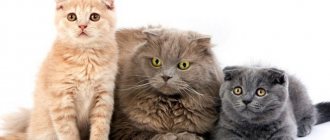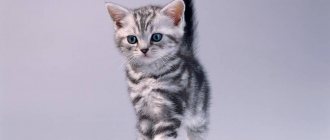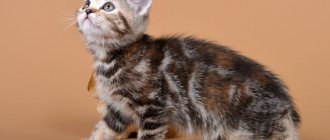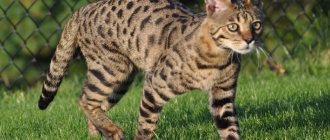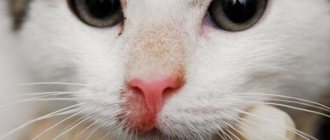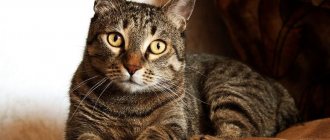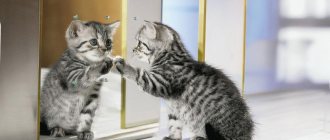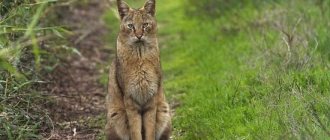The characteristic color with a clear letter “M” on the cat’s forehead is considered the breed standard for the Abyssinian, Egyptian Mau, Singaporean, Somali and Siberian cats. For some varieties of domestic animals, this sign is recognized as a defect, and such kittens are discarded. Mystical fur coloring has given rise to legends that have nothing to do with reality.
History of Tabby color
Tabby is sometimes mistakenly called a cat breed, but it is only a color variety.
In fact, the tabby pattern occurs in many breeds and is a genetic trait common in the general mixed breed population.
The striped pattern is a natural feature that may be related to the coloration of the direct ancestor of domestic pets, the African wildcat (Felis lybica lybica), which, along with the European wildcat (Felis silvestris silvestris) and the Asian wildcat (Felis lybica ornata), have similar colors .
An in-depth scientific study has shown that five genetic clusters are collected from tabby ancestors of wild cats in different parts of the world.
Since the Tabby pattern is a common wild type, it can be assumed that medieval cats were of this color.
However, some scientists believe that this is not true, at least in England. A little later than the mid-17th century, the naturalist John Aubrey noted that William Laud, Archbishop of Canterbury, was “a great cat lover” and his menagerie “was represented by some Cypriot animals, that is, our tabby pets.” He argued that the common variety of English cats had a white color with some bluish inclusions, which was later practically lost. However, most illustrations or drawings of cats in medieval manuscripts do show them to be tabby.
The English term "tabby" comes from the translation of the French phrase "striped silk taffeta", the root of which is tabis, meaning "rich wet silk".
The word originated in France around the 14th century and is derived from the Arabic term "attabiya", which is a reference to the area in Baghdad, Attabiya (named after Prince Attab of the Umayyad Caliphate) where such silk fabric was first made.
"Tabby" can also be compared to the Spanish word "ataviar", which means "to decorate, put on or wear" and often implies luxurious clothing.
Use of the term "Tabby cat" began in the 1690s and was later shortened to Tabby in 1774.
The concept that "Tabby cat" refers to a female may be a reference to the female proper name Tabitha.
Preventive measures for skin disease in cats
- Get the vaccine against fungal diseases (Vakderm) on time.
- Don't let your cat go outside. A pet that walks without control may well come into contact with sick animals.
- Support your pet's immunity. For prevention, give medications to strengthen the liver (Hepatovet) and immunity (Immunofan).
- Give the animal only high-quality food, do not overfeed.
- Consult a doctor at the first symptoms of cat skin diseases and begin treatment immediately.
Tabby Color Genetics
Tabby patterns are caused by three different gene loci and one modifier.
The Agouti gene, with its two alleles A and a, controls whether or not the Tabby pattern is present. The dominant A expresses the basic Tabby pattern, and the recessive "non-Agouti" or "hypermelanistic" allele indicates its absence. Solid (black or blue) cats have an "a" combination that hides the striped pattern, although traces of it can sometimes be seen (called a "ghost stripe"). This basic pattern, whether classic, tabby, spotted or ticked, is most easily distinguishable in bright light during the early stages of a kitten's development and into adulthood on the tail.
However, the Agouti gene only controls the production of black pigment, so a cat with the O allele (responsible for orange or red color) will still express a tabby pattern. As a result, both red cats and red spots on cat skins will always display striped patterns.
The tabby cat's primary pattern gene is dominant, so it is a cat with the Mc genotype (mc or Mc) - mackerel.
The "Mc" set establishes the basic pinstripe pattern (striped mackerel) that underlies the coat. Mc is the wild type Tabby gene. Classic tabby cats are animals that have two copies of the recessive mc, so they are carriers of the mc/mc allele. This is a recessive mutant (not wild type) mc gene that produces the spotted pattern and appears in the cat as the classic pattern of thick stripes with a bullseye pattern on the sides.
The spotted gene is directly related to the Mc gene, it “breaks” the Tabby stripe lines, turning them into spots. It is also dominant, designated Spotted or Sp (sp or Sp). Sp together with Mc and Agouti make up various combinations - mc and Mc/Mc and A/ a and A/A.
The Ticked tabby pattern is at a different gene locus than the Mackerel and Classic tabby patterns, and is epistatic to (influenced by) other patterns. The dominant Ta/ta mutation masks any other Tabby pattern, creating a striped background or agouti stripe with virtually no lines. If the Ticked tabby pattern gene is present, any other Tabby pattern is masked.
Cats homozygous for the marked allele (Ta/ta) have fewer medallion defects than cats heterozygous for the marked allele. When a cat of this genetic makeup is selectively bred for lack of faults and broad stripes on the hair shaft, the resulting pattern is called shaded.
There are additional alleles and even additional genes influencing Tabby patterns that have also been identified and postulated.
The three most common alleles in order of dominance are Ta, the allele for ticked patterns as in the Abyssinian type, Tm, for tabby mackerel, and the recessive tb for classic.
The Ta allele is dominant over Tm and tb.
A cat with the Ta allele will express a ticked tabby pattern (only with stripes on the paws if there is only one copy and none at all if there are two), and a cat with two tb alleles will express the classic stripe pattern.
The wild type is the mackerel (the stripes look like thin fish bones and can break up into linear markers or spots), the most common variety is the classic striped pattern (wide stripes, curls and spirals of dark color on a pale background, usually with bullseye on the side) and, Perhaps the most famous of the less common tabby cat designs is the “swoosh.”
Classic tabbies are most often found in Iran, England and the lands that were once part of the British and Persian empires. The gene responsible for differentiation pattern formation was named transmembrane Q (Taqpep), which also underlies the coat color of the king cheetah.
King Cheetah
Other pattern modifier genes are responsible for creating different types of spotting, many of which are variations of the basic mackerel or classic pattern. There are also hypothetical factors that influence the timing and frequency of Agouti shifts, affecting the width of its band and the quantity and quality of alternating eumelanin and pheomelanin lines on individual hairs.
There is also a gene, not yet identified but believed to be related to the Agouti gene, in the Chausie breed that produces silvery black fur similar to the Abyssinian. It is assumed that the "gray" phenomenon is inherited from the hybridization of the domestic cat with the House (Felis chaus).
Black Chausie
The pigment gene, I/i, is also inhibited. The dominant allele (I) produces hairs with tips of a different color, which are completely colored only on it and have a white base. This allele appears to interact with other genes to cause varying degrees of coloration, ranging from dark-tipped silver tabby to lightly shaded silver and silver chinchilla. The inhibitor gene interacts with the non-Agouti genotype (I-aa) to produce a color known as smoke.
The homozygous recessive genotype combined with the agouti gene (iiA) produces the Tabby's coloration, which can range across the spectrum from a deep-patterned brown tabby to a light yellowish, slightly tinted golden or chinchilla gold. Orange cats with the inhibitor (IO) gene are commonly called "cameos".
Still, the Tabby pattern exists thanks to the Agouti gene. Their stripes have an even distribution of pigment, while the background consists of banded hairs. Tabby cats usually have the following characteristics:
- Mark in the form of the letter "M" on the forehead. Visible in marked tabby cats, but difficult to distinguish in darkened silver and golden animals.
- Thin “pencil” lines on the muzzle. Clearly visible in tabby cats, but more difficult to notice in darkened silver/golden pets.
- Black "eyeliner" and white or pale fur around it.
- Pigmented lips and paw pads.
- Pink nose with darker pigment.
- Ring “girth” of the body, legs and tail. The stripes on the torso disappear when the color is ticked.
Legend of the letter
In the Middle Ages, a cat, especially a black one, could be killed as an “accomplice of the devil.” But the breed with the letter “M” was considered good. It was believed that this was supposedly the seal that the Virgin Mary put on the forehead of a certain cat who warmed the Baby Jesus in the manger on the night of his birth. Since then, the descendants of this individual have been under the protection of the Mother of God. To be fair, it should be said that in the Aramaic language, which Christ spoke, the letter that conveys the sound “m” has a completely different shape. In the Muslim world it is believed that the Prophet Muhammad was partial to these cats.
Types of tabby colors
There are four Tabby patterns that have been shown to be genetically distinct: Mackerel, Classic, Spotted and Ticked.
The fifth pattern includes Tabby as part of another primary color pattern. A patched tabby is a calico or tortoiseshell cat with multi-colored patches (also known as caliby and torbie, respectively).
All of these patterns were found in randomly bred populations. Several additional patterns of this color are found in certain breeds, for example, a modified classic Tabby is seen in the Sokoke. Some of them are associated with the interaction of wild and domestic genes. Rosette and marble patterns are characteristic of the Bengal breed.
Sokoke
Silver Bengal
Thus, even a shallow study of genetic inheritance makes it possible to assume that there are many types of Tabby colors, but the most common of them are the following:
- brindle;
- marble;
- spotted;
- ticked;
- tortoiseshell.
Spotted Tabby
Spotted minke whales have linear markers in their color, divided into spots, which can be located vertically or horizontally. A 2010 study suggests that spotting is caused by modification of mackerel stripes and can cause different phenotypes, such as "broken-type" stripes, through multiple loci.
Ticked Tabby or the T allele usually results in a non-patterned agouti tabby with virtually no stripes or lines.
The stripes often remain to some extent on the face, tail, limbs, and sometimes on the chest in heterozygotes and almost none in homozygotes. Ultimately, the dominant tabby allele is dominant and therefore completely (or mostly) masks all other tabby alleles, hiding other patterns.
Spotted Striped Tabby is a modifier that breaks up the Tabby Mackerel pattern so that the stripes appear as spots. Likewise, the stripes of a classic striped pattern can be broken up into larger spots.
This color can be seen in the Australian Mist, Bengal, Serengeti, Savannah, Egyptian Mau, Arabian Mau, Maine Coon and Ocicat.
Australian mist
brindle tabby
The Ticked (or Stripeless) pattern creates agouti hair, strands of hair with distinct stripes of color, breaking up tabby patterns into “salt and pepper” or “sand.” Residual stripes or "medallions" can often be seen on the lower legs, face and belly, and sometimes at the tip of the tail, as well as a long dark line running along the back, usually along the spine.
A striking representative of this color is the Toyger, a breed that appeared on the basis of the Bengal.
Little Toyger
Mackerel tabby
The Mackerel pattern (often called "Striped Mackerel" in foreign sources) has vertical, slightly curved stripes on the sides of the body. They are narrow and can be continuous or broken into sections and spots on the body and belly.
The "M" mark appears on the forehead along with dark lines on the cat's cheeks and at the corners of her eyes. "Mackerels" are also called "fish seals" and are the most common tabby pattern.
Classic tabby
Classic (also known as "Spotted" or "Marble") Tabby typically has patterns of dark brown, ocher and black, but also comes in all colors except white. These animals are sure to have an "M" mark on the forehead, and the body marking is a swirling or spiral pattern (often called a "bull's-eye") on the sides of the cat.
There is also a light butterfly marker on the shoulders and three thin stripes (the central one is dark) running along the spine. Like Tabby Mackerel, Classic Mackerel have dark lines on the legs, tail and cheekbones.
Causes of skin diseases in cats
Poor care, poor diet, stress, medications, plastic bowls - in veterinary medicine, animal skin diseases can be caused by various reasons. When a pet is sick or frequently encounters an irritant (eg, an allergen), its immunity weakens. She becomes vulnerable to opportunistic organisms that always live in her body (for example, dermatitis mites) and do not normally appear.
Other causes of skin diseases in cats:
- allergies to food, inhaled compounds, flea bites and other substances with which the pet comes into contact;
- communication with sick animals;
- fungal infections;
- bacterial disease of the hair follicles;
- trauma, skin damage, causing inflammation or abscess;
- adverse reactions to medications;
- fleas, ticks;
- hormonal imbalances.
Skin diseases of cats: general symptoms
There are a number of symptoms of skin diseases that will indicate a problem, regardless of the cause:
- severe itching;
- hair loss, bald patches;
- redness;
- dryness, peeling, scabs;
- dull coat color.
The animal constantly itches, scratches, and chews its skin to reduce the pain of symptoms of skin diseases in cats. She may also lick the fur too much to soothe the irritated coat.
Mr. Cat recommends: the most characteristic breeds with tabby color
There are a great variety of tabby cats, ranging from the most common outbred pets or street (yard) cats. The elite cats bred by breeders in nurseries include, for example, the following tabby-colored cats:
- Australian Mysts;
- Arabian Mau;
- Bengal;
- British Shorthair;
- Egyptian Mau;
- Leohouses;
- Maine Coons;
- Oriental;
- Ocicats;
- Pixie Bobs;
- Savannah;
- Safari;
- Serengeti;
- Siberian;
- Sokoke;
- Toygers;
- Ceylonese;
- Chinese Li-Hua;
- Highlanders;
- Scottish Fold and Straight.
Fold
Straight
The only breed in which the type of color is present even in the name is the Asian Tabby.
Clinical signs and associated symptoms
The occurrence of ulcers, crusts and other sores in cats may be accompanied by:
- dandruff;
- dulling of wool;
- itching;
- changes in skin pigmentation;
- hair loss;
- temperature rise.
To determine an accurate diagnosis, you will need to examine the cat, collect anamnesis and perform some tests.
